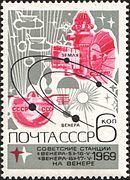SATCAT no. 3648 Launch mass 1,130 kg Rocket Molniya-M | COSPAR ID 1969-002A Spacecraft 2V (V-69) No.331 Launch date 10 January 1969 Last contact 17 May 1969 | |
 | ||
Similar | ||
Venera 6 (Russian: Венера-6 meaning Venus 6), manufacturer's designation: 2V (V-69) No.331, was a Soviet spacecraft, launched towards Venus to obtain atmospheric data. It had an on-orbit dry mass of 1,130 kilograms (2,490 lb).
Contents
The spacecraft was very similar to Venera 4 although it was of a stronger design. When the atmosphere of Venus was approached, a capsule with a mass of 405 kilograms (893 lb) was jettisoned from the main spacecraft. This capsule contained scientific instruments.
During descent towards the surface of Venus, a parachute opened to slow the rate of descent. For 51 minutes on May 17, 1969, while the capsule was suspended from the parachute, data from the Venusian atmosphere were returned. It landed at 5°S 23°E.
The spacecraft also carried a medallion bearing the State Coat of Arms of the U.S.S.R. and a bas-relief of V. I. Lenin to the night side of Venus.
Given the results from Venera 4, the Venera 5 and Venera 6 landers contained new chemical analysis experiments tuned to provide more precise measurements of the atmosphere's components. Knowing the atmosphere was extremely dense, the parachutes were also made smaller so the capsule would reach its full crush depth before running out of power (as Venera-4 had done).
